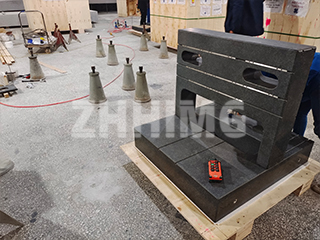As a core metrological tool in precision manufacturing, the Granite CMM Platform (also known as marble coordinate measuring machine table, precision granite measuring table) is widely recognized for its superior stability and accuracy. Note: It is occasionally misclassified with cast iron CMM platforms in the market, but the natural mineral composition of granite endows it with irreplaceable advantages in high-precision measurement scenarios— a critical distinction for professionals seeking reliable metrological benchmarks.
1. Core Definition & Primary Applications
The granite CMM platform is a precision-measuring benchmark tool crafted from high-grade natural granite, engineered through CNC machining and hand-finishing processes. Its primary applications include:
- Serving as the foundational workbench for coordinate measuring machine (CMM) operations, enabling accurate dimensional inspection of mechanical components.
- Supporting precision testing of machine tools, verifying geometric accuracy (e.g., flatness, parallelism) of machine tool worktables.
- Conducting dimensional accuracy and form deviation assessments of high-precision parts (e.g., aerospace components, automotive precision parts).
- Featuring three standardized reference markers on its working surface, facilitating rapid calibration and positioning of CMM probes for efficient measurement workflows.
2. Mineral Composition & Natural Performance Advantages
2.1 Key Mineral Composition
High-quality granite platforms are primarily composed of:
- Pyroxene (35-45%): Enhances structural density and wear resistance.
- Plagioclase feldspar (25-35%): Ensures uniform texture and low thermal expansion.
- Trace minerals (olivine, biotite, magnetite): Contribute to the material’s black luster and magnetic resistance.
After hundreds of millions of years of natural aging, the internal stress of the granite is fully released, resulting in a stable crystalline structure that eliminates post-processing deformation— a unique advantage over man-made materials.
2.2 Technical Advantages
Compared to cast iron or composite material platforms, granite CMM platforms offer unparalleled performance:
- Exceptional Stability: Zero internal stress from natural aging ensures no dimensional deformation under long-term or heavy loads (up to 500kg/m² for standard models).
- High Hardness & Wear Resistance: Mohs hardness of 6-7 (exceeding cast iron’s 4-5), ensuring minimal surface wear even after 10,000+ measurement cycles.
- Corrosion & Magnetic Resistance: Impervious to acids, alkalis, and industrial solvents; non-magnetic properties avoid interference with precision magnetic measurement tools.
- Low Thermal Expansion: Linear expansion coefficient of 5.5×10⁻⁶/℃ (1/3 of cast iron), minimizing dimensional deviations caused by ambient temperature fluctuations.
- Low Maintenance: Smooth, dense surface (Ra ≤ 0.4μm) requires no rust-proofing or regular lubrication; simple wiping with a lint-free cloth maintains cleanliness.
3. Precision Standards & Tolerance Specifications
The flatness tolerance of granite CMM platforms strictly adheres to the GB/T 4987-2019 standard (equivalent to ISO 8512-1) and is classified into four precision grades. The flatness tolerance formula is as follows (D = diagonal length of the working surface, in mm; measurement temperature: 21±2℃):
- Class 000 (Ultra-Precision): Tolerance = 1×(1 + D/1000) μm (suitable for ultra-high-precision CMMs in laboratory environments).
- Class 00 (High Precision): Tolerance = 2×(1 + D/1000) μm (ideal for industrial-grade CMMs in automotive/aerospace manufacturing).
- Class 0 (Precision): Tolerance = 4×(1 + D/1000) μm (used for general machine tool testing and part inspection).
- Class 1 (Standard): Tolerance = 8×(1 + D/1000) μm (applicable to rough machining quality control).
All UNPARALLELED granite platforms undergo third-party metrological verification, with a traceable precision report provided for each unit— ensuring compliance with international quality requirements.
4. Working Surface Requirements & Limitations
4.1 Quality Criteria for Working Surfaces
To guarantee measurement accuracy, the working surface of granite CMM platforms must be free from defects that affect performance, including:
- Sand holes, shrinkage cavities, cracks, or inclusions (which cause uneven force distribution).
- Scratches, abrasions, or rust stains (which distort measurement reference points).
- Porosity or uneven texture (which leads to inconsistent wear).
Non-working surfaces (e.g., side edges) allow for professional repairs of minor dents or chamfer defects, provided they do not impact structural integrity.
4.2 Technical Limitations & Mitigation
While granite platforms excel in precision, they have specific limitations that professionals should note:
- Impact Sensitivity: Cannot withstand heavy impacts (e.g., dropping metal parts); impacts may cause micro-pits (though not burrs, which avoids affecting measurement accuracy).
- Humidity Sensitivity: Water absorption rate is ~1%; prolonged exposure to high humidity (>60%) may cause slight dimensional changes. Mitigation: Apply a specialized silicone-based waterproof coating (provided free with UNPARALLELED orders).
5. Why Choose UNPARALLELED Granite CMM Platforms?
- Material Sourcing: We exclusively use “Jinan Black” granite (a premium grade with <0.1% impurity content), ensuring uniform texture and stable performance.
- Precision Machining: Combined CNC grinding (tolerance ±0.5μm) and hand-polishing (Ra ≤ 0.2μm) processes exceed industry standards.
- Customization: We offer non-standard sizes (from 300×300mm to 3000×2000mm) and specialized designs (e.g., T-slot grooves, threaded holes) to match your CMM model.
- After-Sales Support: 2-year warranty, free annual precision re-calibration, and global on-site maintenance (covering Europe, North America, and Southeast Asia).
Post time: Aug-21-2025

